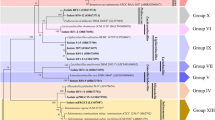Abstract
The nutritional requirements forPrevotella sp. 4PCCNB2 isolated from the rumen of a native goat in Korea and those of the ATCC 19189 strain isolated from the bovine rumen were investigated. The two strains grew well with ammonium sulfate as the sole added nitrogen source. However, neither a complex of amino acids nor casein hydrolysate effectively replaced ammonium sulfate. Biotin,p-aminobenzoic acid, and vitamin B12 were essential to culture the ATCC 19189 strain. Unlike the ATCC 19189 strain, however, B12 was only stimulatory for the growth of the 4PCCNB2 strain. The 4PCCNB2 strain grew well in the basal medium without an individual acid such as acetic acid or valeric acid. In contrast, either acetic or valeric acid was absolutely required for the growth of the ATCC 19189 strain.
Similar content being viewed by others
References
Stewart, C. S. and M. P. Bryant (1988) The rumen, bacteria. pp. 21–75. In: P. N. Hobson (eds.).The rumen microbial ecosystem. Elsevier Applied Science, England.
Caldwell, D. R., D. C. White, M. P. Bryant, and R. N. Doetsch (1965) Specificity of the hemin requirement for growth ofBacteroides ruminicola.J. Bacteriol. 90: 1645–1654.
Strobel, H. J. (1992) Vitamin B12-dependent propionate production by the ruminal bacteriumPrevotella ruminicola 23.Appl. Environ. Microbiol. 58: 2331–2333.
Marounek, M. and D. Duskova (1999) Metabolism of pectin in rumen bacteriaButyrivibrio fibrisolvens andPrevotella ruminicola.Lett. Appl. Microbiol. 29: 429–433.
Klieve, A. V., G. L. Heck, M. A. Prane, and O. Shu (1999) Genetic homogeneity and phage susceptibility of ruminal strains ofStreptococcus bovis isolated in Australia.Lett. Appl. Microbiol. 29: 108–112.
Griswold, K. E., B. A. White, and R. I. Mackie (1999) Diversity of extracellular proteolytic activities amongPrevotella species from the rumen.Curr. Microbiol. 39: 187–194.
Russell, J. B., F. J. Delfino, and R. L. Baldwin (1979) Effects of combinations of substrates on maximal growth rates of several rumen bacteria.Appl. Environ. Microbiol. 37: 544–549.
Pittman, K. A. and M. P. Bryant (1964) Peptides and other nitrogen sources for growth ofBacteroids ruminicola.J. Bacteriol. 88: 401–410.
Scott, H. W. and B. A. Dehority (1965) Vitamin requirements of several cellulolytic rumen bacteria.J. Bacteriol. 80: 1169–1175.
Dehority, B. A., H. W. Scott, and P. Kowaluk (1967) Volatile fatty acid requirements of cellulolytic rumen bacteria.J. Bacteriol. 94: 537–543.
Yanke, L. J., H. D. Bae, L. B. Selinger, and K. J. Cheng (1998) Phytase activity of anaerobic ruminal bacteria.Microbiology 144: 1565–1573.
Park, K. M. and K.H. Kang (1993) Isolation and identification of rumen bacteria from Korean native goat. II. Isolation and identification of Gram negative bacterial.Korean J. Dairy Sci. 15: 178–187.
Bryant, M. P. and I. M. Robinson (1962) Some nutritional characteristics of predominant culturable ruminal bacteria.J. Bacteriol. 84: 605–614.
Varel, V. H. and M. P. Bryant (1974) Nutritional features ofBacteroides fragilis subsp.fragilis.Appl. Environ. Microbiol. 18: 251–257.
Linehan, B., C. C. Scheifinger, and M. J. Wolin (1978) Nutritional requirements ofSelenomonas ruminantium for growth on lactate, glycerol, or glucose.Appl. Environ. Microbiol. 35: 317–322.
Choi, A., S. G. Kim, B. D. Yoon, and H. M. Oh (2000) Growth and amino acid contents ofSpir ulina platensis with different nitrogen sources.Biotechnol. Biotrocess Eng. 8: 368–372.
Bryant, M. P. (1972) Commentary on the Hungate technique for culture of anaerobic bacteria.Am. J. Clin. Nutr. 25: 1324–1328.
Oh, Y. K., M. S. Park, E. H. Seol, S. J. Lee, and S. Park (2003) Isolation of hydrogen-producing bacteria from granular sludge of an upflow anaerobic sludge blanket reactor.Biotechnol. Bioprocess Eng. 8: 54–57.
Madeira, H. M. F. and M. Morrison (1997) Growth inhibition ofPrevotella ruminicola by protamine.FEMS Microbiol. Lett. 150: 81–88.
Author information
Authors and Affiliations
Corresponding author
Rights and permissions
About this article
Cite this article
Shin, H.T., Lee, S.W., Park, K.M. et al. Nutritional requirements ofPrevotella sp. Isolated from the rumen of the goat. Biotechnol. Bioprocess Eng. 9, 313–317 (2004). https://doi.org/10.1007/BF02942350
Received:
Accepted:
Issue Date:
DOI: https://doi.org/10.1007/BF02942350




